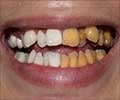The world's smallest plasma torch that may one day make root canal treatment faster and less painful, has been developed by scientists at the University of Southern California (USC).
The world's smallest plasma torch that may one day make root canal treatment faster and less painful, has been developed by scientists at the University of Southern California (USC). The torch could also reduce infection rates.
"Our goal is to guarantee that you won't have to see a doctor for a follow-up visit," ABC Science quoted says Professor Chunqi Jiang Jiang, who has reported this work in the online edition of the journal Plasma Processes and Polymers, as saying."One problem is that between 8 per cent and 10 per cent of patients have an infection post-operation. This is intended to eliminate the chance of an infection," the researcher added.
Plasma, or ionized gas, is one of the four basic states of matter, the other three being solid, liquid and gas.
The researchers reveal that the trick to creating plasma at room temperature is to pulse it. They say that a continuous stream of plasma very quickly heats up the surrounding air.
According to them, pulsing the plasma allows the tiny electrons in it to heat up and move around, while keeping the much larger and heavier atom nucleus from heating up.
"If you have a piece of paper with bacteria on it and you apply cold plasma to it, the paper won't burn but the bacteria will die," says Professor Mounir Laroussi, of Old Dominion University in Virginia, who has studied the effect of cold plasmas for years.
Advertisement
The researchers say that upon being used in the mouth, the free electrons of plasma create single atoms of pure oxygen, ozone and other reactive forms of oxygen, all of which search for other atoms to bind with in the organic biofilms inside decayed teeth.
The researchers have revealed that cool, pulsed and purple plasma takes about five to ten minutes to clear an infected tooth of biofilms as compared to bleach, the conventional method for cleaning an infected tooth, which takes 30 minutes.
While about 10 per cent of patients treated with bleach are still infected, tests using the plasma torch on a few dozen human teeth have shown no signs of infection.
The plasma torch is also not as expensive as laser systems that are used as high-tech solutions to biofilms.
While laser systems costing up to 25,000 dollars, the plasma torch could retail for as little as 1,000 dollars, provided it passes official clinical trials.
Laroussi, who used to test cold plasmas effect on teeth, skin and wound healing, says that the trick to regulatory acceptance and commercialisation is ensuring that only harmful cells are killed.
"We can kill bacteria on teeth and on wounds. But we have to ensure that we are not creating a worse problem in nearby healthy cells as well," says Laroussi.
Initial tests have shown that surrounding healthy tissue remains intact, although more testing is needed to definitively prove this.
Meanwhile, the USC researchers are concentrating on getting the funding necessary to continue with their research.
Source-ANI
RAS










